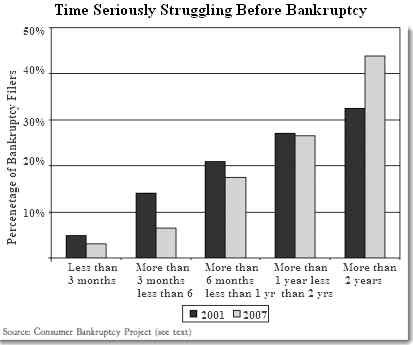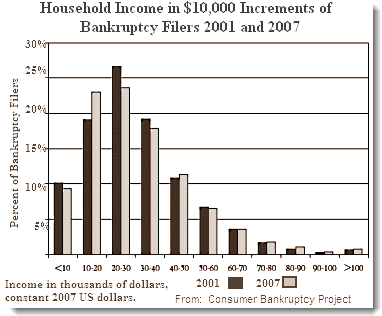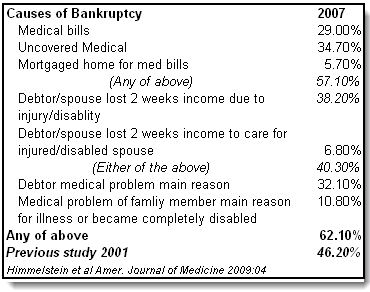Beyond ForeclosureGate – It Gets Uglier

The ForeclosureGate scandal poses a threat to Wall Street, the big banks, and the political establishment. If the public ever gets a complete picture of the personal, financial, and legal assault on citizens at their most vulnerable, the outrage will be endless. (Image)
Foreclosure practices lift the veil on a broader set of interlocking efforts to exploit those hardest hit by the endless economic hard times, citizens who become financially desperate due medical conditions. A 2007 study found that medical expenses or income losses related to medical crises among bankruptcy filers or family members triggered 62% of bankruptcies. There is no underground conspiracy. The facts are in plain sight.
ForeclosureGate represents the sum total illegal and unethical lending and collections activities during the real estate bubble. It continues today. Law professor and law school dean Christopher L. Peterson describes the contractual language for the sixty million contracts between borrowers and lenders as fictional since the boilerplate language names a universal surrogate as creditor (Mortgage Electronic Registration System), not the actual creditor. Other aspects of ForeclosureGate harmed homeowners but the contractual problems that the lenders created on their own pose the greatest threats.
When the Massachusetts Supreme Court upheld a lower court ruling that the actual creditor must named in the mortgage agreement (a legal requirement that the banks forgot to meet in their contracts), there was consternation on Wall Street. What would happen if a class action lawsuit challenged these flawed mortgages? Isn’t the Massachusetts decision the latest of many attacking the legal basis of the shoddy business practices and boilerplate industry contracts? What if homeowners started walking away from their underwater mortgages based on the legally flawed contracts? If there were a viable prospect of a class action suit against financial institutions threatening to invalidate these contracts, wouldn’t that crash the stock values of the big banks and some Wall Street firms?
The big banks and their partners on Wall Street need a preemptive strike to derail the legal process that threatens their existence. They may get a temporary reprieve through pending consent decrees from the United States Department of Justice and consortia of state attorney’s general. If that protection fails, big money will make every effort to buy a bill from Congress that absolves them retroactively, en masse. The consent decree might cost them a few billion dollars. That’s much better than owing the trillions in lost home values due to their contrived real estate bubble and stork market crash.
As bad as this is, it gets worse.
Beyond ForeclosureGate
The surface scandal is about fraudulent business practices and a systematic assault on homeowners by lenders, servicers, and the legal system. A much broader picture must be viewed in order to understand the utter contempt that the ruling elite has toward citizens and the depraved tactics used to express that contempt, all to serve endless desire to accumulate more money and power.
The set up began when we heard about the ownership society in the 2004 presidential election. President Bush defined ownership as taking the government out of our lives so more people could own homes and control their destinies. The foundation was home ownership. As Bush said on the campaign trail, “We’re creating a home — an ownership society in this country, where more Americans than ever will be able to open up their door where they live and say, welcome to my house, welcome to my piece of property” October 2, 2004.

Then Federal Reserve Chairman Alan Greenspan was uncharacteristically coherent when he laid the foundation for the swindle earlier that year. Greenspan told the Credit Union National Association that the fixed rate mortgage was “an expensive way of financing a home.” He was clear when he advised lenders that, “consumers might benefit if lenders provided greater mortgage product alternatives to the traditional fixed-rate mortgage.” February 2, 2004. Home equity through exotic mortgage products fueled consumption and became the new “margin account.”
The Chairman of the Federal Reserve and the president ratified the real estate bubble, already underway at the time, as political and financial doctrine. The advice was clear. Get an ARM, own your piece of the American Dream and spend that equity. Housing prices never go down, right?
Freddie Mack, Fannie Mae, Wall Street and the big banks provided the back room. Mortgage Backed Securities (MBS) derivatives were vastly expanded. This made it easy for more homebuyers to qualify for mortgages they might not otherwise get, credit standards dropped. Those with good credit saw an array of tantalizing zero interest loans and other mortgage products to maximize available cash and feed the stock market.
It was all good until it wasn’t.
The real scandal is the unfathomable loss of wealth and opportunities by the vast majority of citizens and the vicious attack on the most vulnerable citizens as a part that process. The attack continues and is worthy of review.
Foreclosure and Bankruptcy
Foreclosure is the down side of the ownership society. When you’re sold a bill of goods, a property that you were told you were qualified to buy, and you lose it, you are evicted from ownership island.
Before Congress passed the 2005 bankruptcy reform act, homeowners could avert foreclosure in many states by filing for bankruptcy. Not just anyone could qualify. The process of qualifying was difficult and, oftentimes humiliating. But homes were saved and families were preserved with a chance to start over.
A myth emerged of the bankruptcy abuser, a high-class sort of welfare cheat. These reckless people worked the system to rack up large debts that were subsequently wiped clean through bankruptcy. The alleged abuse of the system became the excuse for a major overhaul of bankruptcy law. The legislation passed the Senate with 74 yes votes and soon became law.
The changes since the 2005 legislation provide substantial benefits to creditors. Morgan et al summarized the direct benefits to creditors in a forthcoming publication in the New York Fed’s Economic Policy Review. Before bankruptcy reform, the filer of a bankruptcy claim used to determine Chapter 7 or 13 filing status. That makes a difference in the amount and type of debt relief. The legislation imposes means test that determines precisely which chapter (7 or 13) filers must use. Significantly, chanter 13 filers retain more debt from medical and other unsecured credit.
Legal costs ranged from $600 to $1500 before bankruptcy reform. Legal fees now range between $2800 and $3700. Previously, there was no requirement for credit counseling prior to filing.
Filers must now document approved credit counseling six months before filing or face dismissal of their case(Morgan et al.). This counseling requirement can lead to unwarranted dismissals or inordinate delays in filing at a time when filers need relief.
Under the old law, only bankruptcy trustees appointed by the federal court could file claims of abuse by the filer. Under the new legislation, anyone can file a claim of bankruptcy abuse, which can lead to a dismissal of the cause. This is a huge benefit to lenders who wanted to keep citizens from realizing debt relief.
The Real Benefit for Big Money – Delayed Bankruptcy Filings
The new law makes it harder to file a claim, doubles costs, and gives the creditors a say in claiming fraud on the part of those who file claims. Significant delays in filing for bankruptcy became the norm.
Time is money for loan servicers. A long delay before a bankruptcy filing, allows servicers the opportunity to add on special fees, many of which the borrower can’t comprehend. One thorough study showed that many of these fees were questionable. The longer it takes, the greater the revenue opportunities. Delay benefits creditors since loan payments continue at their original level.
What happened to those big spending, reckless bankruptcy abusers that were the rationale for the 2005 reforms? The following graph from the Consumer Bankruptcy Project shows that there is virtually no difference between the incomes of filers before and after bankruptcy reform. The majority of filers made between ten and forty thousand dollars a year before reform. That has remained virtually unchanged. The big spending abusers were and remain a mythical construct; the centerpiece of a diversion strategy to keep attention away from this never-ending gift to creditors.
These newly empowered creditors were the same creditors who hired debt collectors to try and frighten people out of their filings. A major study found that 24% of filers reported that debt collectors told deliberate lies to avoid bankruptcy. They herd that filing for bankruptcy would lead to jail, job loss, or an IRS audit. Some were told that it was illegal to file for bankruptcy. Lawless, et al. Did the Bankruptcy Reform Fail? An Empirical Study, October 2008
The deck was stacked early against citizens and protection from creditors disappeared under the new law. The creditors, who so recklessly precipitated the economic collapse, came out on top. They were free to profit in any way they could from their new market,
What Causes Bankruptcy – Financial Shocks from Medical Expenses
Prior to the new law, the major cause of bankruptcy stemmed from medical care expenses and the resulting disruptions to families. Rather than the mythical big spender contrived by Congress, for nearly half of filers, major medical expenses, family tragedies, were the tipping point to a loss of financial viability.
The Consumer Bankruptcy Project audited a representative sample of bankruptcy filers in 2001. The audit found that 46% cited a “major medical cause” for bankruptcy. This includes the direct cost of uncovered medical bills for major illness or injury, lost work due to the same, and the need to mortgage the family home to cover medical costs.
Did Congress review this data? Were they intent on making it harder to file bankruptcy as a result of illness? When bankruptcy is delayed or simply not attainable, less money is available for needed medical care. Were the members supporting bankruptcy reform indifferent to the suffering compounded by their thoughtless legislation?
The situation is worse now. A comprehensive survey of those who filed bankruptcy in 2007 showed the increasing desperation of those faced with medical problems. When individuals or family members are in dire need of medical care, do they just sit home and suffer?
Nearly two thirds of bankruptcies result from medical care that people can’t afford or losses in income from medically required leave. Where are the big spending cheats?
Nihilists at the Helm
The big banks, Wall Street, the politicians they own, and the Federal Reserve Board created the real estate bubble in bad faith.
They knew or should have known:
- that the real estate bubble was unsustainable;
- when the bubble deflated, many homeowners would hit a financial wall; and, that
- when homeowners hit the wall, to maintain viability for their families, they would need relief of some sort.
What did the nihilists of the financial elite and their hit men walking the halls of power do with all this knowledge? They went ahead with the real estate bubble, fostered it, deregulated meaningful controls on the financial industry, and crafted a new bankruptcy law to stick it to filers. They knew or should have know that data from 2001 showed a very high rate of filings due to the financial stress of medical care. Did they care? Do they care now? Has anything been done to correct this injustice?
While citizens suffer in financial distress, often due to illness, at the behest of influential bankers and investors, the Department of Justice crafts a settlement with lenders and their representatives to relieve them of the stern justice due for their specific crimes and the larger horrors they visit upon citizens, all in the name of short term profit.
We are most emphatically not a nation of laws. We are a nation where the law is used by a very few for their own purposes, without regard for the well being of the nation or its citizens. We are a lawless nation
END
This article may be reproduced entirely or in part with attribution of authorship and a link to this article.
~


 From
From  From Did
From Did  From
From
Yikes!….all of this is a horrible nightmare. We will wake up one day and life will be as it was before this rude awakening……FRAUD!….iF ONLY!
If the disaster that we are sitting in the middle of was caused from a few crazed people, we could take them out of commission by putting them behind bars for the rest of their natural lives.
From what I see and read the corruption is in every segment of our lives…with the exception of the people on “Main Street”. We live by he laws of the land because we are good citizens and do what we are told. We conform to the rules of society…..W H i i i i i i i i i i i L E ! ! the rest of this Countries are out and out depraved CRIMINALS…
This is something we have all become painfully aware of since the bitter pill of FORECLOSURE FRAUD has been rammed down our throats……We are all enraged over all that has come out from under the carpet….
HOWEVER!….This is not the worst of it…the worst is we are sitting back watching and waiting for all of the same depraved CRIMINALS who deliberately, through cold and calculating deeds have taken away our most prized possession…..our homes.
We now are giving these same people the ability to make this right for the citizens of “Main Street”, who we already know are back peddeling so they don’t lose any of their stollen money…. HELLO !, HELLO!, You all know as well as I…..all we are doing is giving them the time to put into law a process by which we lose, lose and hey win, win. They will forgive The Banks….They get to keep all of our money and homes….ALL IN THE NAME OF IT IS WHAT IS BEST FOR OUR ECONOMY AND COUNTRY.
Hell, I cannot think of a better reason to impeach the whole lot of them. Get them out of CONTROL. That includes the Judges all politicians. We would never know for sure if any of them are truly innocent or not. WE THE PEOPLE WRITE THE LAW, THAT IS FAIR AND EQUAL TO ALL. AND…..punish the rest of the slime so they can never hurt us again….Besides….,prison, freeze all of their assets, until we can figure out an estimate of the value of the homes already foreclosed and give the citizens their money back or their home or if still vacant, repair the homes that are in disrepair because of sitting vacant….as that grinning, smirking, cocky, pompous representative from Deutsche Bank so delicately told us as they were discussing bulldozing our homes…..Then, total the remaining money that has been frozen.give back to all of the citizens who have been put through years of this freaking hell….and move on with our lives.
Oh, but wait, we will need people to govern. WE THE PEOPLE will vote for one one of our own for the positions that were held by the criminals of the century..
Just a little humor here!…..Do any of remember the ORIGINAL Movie….”The Invasion of the body snatchers?” There was a pod placed near all he citizens of the town….and when they fell to sleep these pods would open and be identical to one of the citizens…and replace that person. These people who were replaced no longer had any emotions.. Well think about this…..that is almost like it feels in our Country….those criminals are walking around among us and we cannot know for certain if they are one of THEM or not . So, they all go! This is the time where you do throw he baby out with the bath water!
Desperate people do desperate things!…..WE THE PEOPLE, need to take care of each other, The trust will come back and America will be the greatest Nation in the world once again and forever!
I F O NL Y !!
Nancy
Thank you Michael Collins and all here for insight and skills at leaving together various factors.
This forum is a great source of information on foreclosure fraud – and now as has been awaited a reflection on mortgage fraud itself where one might see that homes were in actuality taken by the nature and circumstances of the loan or alleged loan itself in real time.
It is heartbreaking to learn of children and their loving parents displaced from their homes and often on the hopes attached to a first purchase.
Also to be considered is extreme elder-abuse on older persons whose prior, in-place mortgages were being steadily paid until offered a great “opportunity” to downsize debt in the face of severe economic downturns. “Opportunities” of course requiring going delinquent as a qualification.
Where widows widowers and others living alone for instance, frail or robust, are going to go – is unclear – as is the status of all property of every sort.
Ideas?
Oops, sorry, typo.
Meant “weaving together”.
(Although if we can afford a sense of humor – maybe the typo in” leaving together” as typed above is not without meaning).
” If the public ever gets a complete picture of the personal, financial, and legal assault on citizens at their most vulnerable, the outrage will be endless.”
We’re educating home-owners about MERS clouding of title, breaking the story down so that everyone understands this affects all home-owners – not just those in foreclosure.
We’re making headway and are urging home-owners with clouded title (MERS) mortgages/securities to file clear title actions.
It is our hope that we can provide all home-owners with an orderly method to determine identity of their true lender and negotiate a new deal at the current market value. For those who lost their homes in foreclosure or short sale, we believe relief should be provided by state courts on a case-by-case basis. All borrowers are unique – one size fits all solution will not do.
We agree that bankuptcy laws need to change so that judges are empowered to cram down mortgages on principal residences. We have propsed this to members of Congress, but the TBTF mantra has clearly taken hold, so more work needs to be done on this issue.
We’re havivng more success with NJ Governor, Supreme Court and County Clerks, who are considering our Constitution-based solutions.
This is not a left/right issue. All home-owners have been harmed. It’s an opportunity for people of all political persuasions to work together and restore property rights, due process, states rights and the rule of law.
If you would like to spread the word, and get these solutions in front of your state representatives, visit:
http://www.njteapartycoalition.org. The Systemic Mortgage Fraud presentation can be viewed and/or downloaded from the site.
i thank michael collins for his reports on fraudclosure.
it is not enough that decent people are outraged. we ARE outraged.
the courts and elected officials need to clean up this swampy foreclosure and predatory lending muck.
give back money damages to the victims who have been defrauded.
Interesting…thanks..
After reading this and seeing the picture of that evil thing, that traitor of America, the abominable, George W. Bush, I felt the need to sprinkle myself with some holy water. I find him a particularly despicable treasonist. One of the worst ones, though all of the Presidents contributed and played an integral role in this nightmare he is who I most despise..
I agree! And combined with that pic of the ever-lying slimy elitist turbotaxtimmy was enough to get my BP boiling.
I vent…I would need more than a sprinkle of holy water…LOL……to be honest….I really have not cared for any of them for many years….. BUT….I did not like Bush sr. or his ‘clone ‘….it may have been from the bad ‘ thoughts ‘ I had after reading of Prescot Bush…many years ago about the times before and after the war. So I always felt there was a shady undercover hiden scheme with them……..very uneasy to explain vibes….